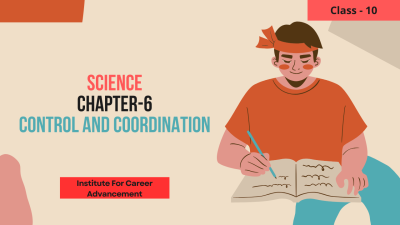Control And Coordination - Class 10
In Class 10, Control and Coordination deals with how our body senses the environment and reacts accordingly. Here's a short description: The Big Picture: It's about how different body parts work together to allow you to respond to your surroundings. Imagine dodging a ball - your eyes see it, your brain sends signals, and your muscles move you out of the way. Key Players: The nervous system (brain, spinal cord, nerves) acts as the control center, sending messages. The endocrine system (hormones) also plays a role in coordinating some responses. Sensing the World: Sense organs like eyes, ears, nose, tongue, and skin detect changes (light, sound, smell, taste, touch). Taking Action: Muscles receive signals from the nervous system and contract or relax, allowing you to move and react. দশম শ্রেণীতে, কন্ট্রোল অ্যান্ড কোঅর্ডিনেশন আমাদের শরীর কীভাবে পরিবেশকে অনুধাবন করে এবং সেই অনুযায়ী প্রতিক্রিয়া জানায় তা নিয়ে আলোচনা করে। এখানে একটি সংক্ষিপ্ত বিবরণ দেওয়া হলঃ দ্য বিগ পিকচারঃ এটি হল কীভাবে শরীরের বিভিন্ন অঙ্গগুলি একসাথে কাজ করে যাতে আপনি আপনার আশেপাশে সাড়া দিতে পারেন। একটি বল এড়িয়ে যাওয়ার কথা কল্পনা করুন-আপনার চোখ এটি দেখতে পায়, আপনার মস্তিষ্ক সংকেত পাঠায় এবং আপনার পেশীগুলি আপনাকে পথ থেকে সরিয়ে দেয়। মূল খেলোয়াড়ঃ স্নায়ুতন্ত্র (মস্তিষ্ক, মেরুদণ্ড, স্নায়ু) নিয়ন্ত্রণ কেন্দ্র হিসাবে কাজ করে, বার্তা প্রেরণ করে। অন্তঃস্রাবী তন্ত্রও (হরমোন) কিছু প্রতিক্রিয়ার সমন্বয়ে ভূমিকা পালন করে। বিশ্বকে অনুধাবন করাঃ চোখ, কান, নাক, জিহ্বা এবং ত্বকের মতো ইন্দ্রিয়গুলি পরিবর্তনগুলি (আলো, শব্দ, গন্ধ, স্বাদ, স্পর্শ) সনাক্ত করে। পদক্ষেপ নেওয়াঃ পেশীগুলি স্নায়ুতন্ত্র থেকে সংকেত গ্রহণ করে এবং সঙ্কুচিত বা শিথিল হয়, যা আপনাকে নড়াচড়া এবং প্রতিক্রিয়া করতে দেয়।
English
Last updated
Wed, 27-Nov-2024



















